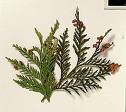Northern White cedar Tree Information
Images of Northern White cedar:






Northern White cedar grows in the following 24 states and provinces:
Connecticut, Hawaii, Illinois, Indiana, Maine, Manitoba, Maryland, Massachusetts, Michigan, Minnesota, New Brunswick, New Hampshire, New York, Nova Scotia, Ohio, Ontario, Pennsylvania, Prince Edward Island, Rhode Island, Tennessee, Vermont, Virginia, West Virginia, WisconsinInformation about Northern White cedar:
The Thuja Occidentalis is commonly known as the Arbor Vitae, Arborvitae, Eastern Arborvitae, Eastern White-cedar, Northern White Cedar, Northern White-cedar, Swamp-cedar, White Cedar as well as White-cedar.
The currently accepted scientific name for northern white-cedar is Thuja occidentalis L. . There are no recognized subspecies, varieties, or forms. Northern white-cedar occurs in southeastern Canada and the adjacent northern United States. It is distributed from southwestern Nova Scotia, Prince Edward Island, New Brunswick, the Gaspe Peninsula in Quebec, and Anticosti Island in the Gulf of Saint Lawrence; west to northern Ontario and southeastern Manitoba; south to southeastern Minnesota and northern Illinois; and east through extreme northwestern Indiana, Michigan, and the New England states. Island populations occur in the Appalachian Mountains in western Pennsylvania, West Virginia, Virginia, and eastern Tennessee. Local populations also occur in west-central Manitoba, Wisconsin, Minnesota, Illinois, and Ohio . Historical evidence indicates that northern white-cedar is native to North Carolina as well, but no known native population occurs there now .Northern white-cedar is an important species in the wet-mesic coniferous forests of the northern lowlands . It is often present in the ecotone between sphagnum bog and upland hardwood communities . It may dominate rich swamp forests, poor swamp forests, and the cedar string bog and fen complex . The following published classifications list northern white-cedar as dominant or codominant: The vegetation of Wisconsin Virgin plant communities of the Boundary Waters Canoe Area Plant communities of Voyageurs National Park, Minnesota, U.S.A. Habitat classification system for Upper Peninsula of Michigan and northeast Wisconsin Classification and gradient analysis of forest vegetation of Cape Enrage, Bic Park, Quebec The principal plant associations of the Saint Lawrence Valley Some of the information provided here is attributed to:Carey, Jennifer H. 1993. Thuja occidentalis. In: Fire Effects Information System, [Online]. U.S. Department of Agriculture, Forest Service, Rocky Mountain Research Station, Fire Sciences Laboratory (Producer). , available at the USDA Fire Effects Information System (FEIS) website